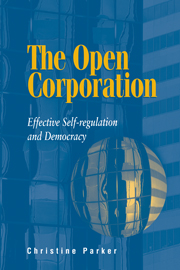Book contents
- Frontmatter
- Contents
- List of tables and figures
- Preface
- Acknowledgements
- 1 Introduction: Corporate self-regulation in the new regulatory State
- 2 The potential for self-regulation
- 3 Motivating top-management commitment to self-regulation
- 4 Cultivating self-regulation leadership
- 5 Self-regulation methodology and social harmony
- 6 The pathologies of self-regulation
- 7 Model corporate Citizens: The role of self-regulation Professionals
- 8 The three strategies of ‘permeability’ in the open Corporation
- 9 Meta-regulation: The regulation of self-regulation
- 10 Conclusion
- Appendix: Methodology
- Notes
- Reference
- Index
5 - Self-regulation methodology and social harmony
Published online by Cambridge University Press: 05 July 2014
- Frontmatter
- Contents
- List of tables and figures
- Preface
- Acknowledgements
- 1 Introduction: Corporate self-regulation in the new regulatory State
- 2 The potential for self-regulation
- 3 Motivating top-management commitment to self-regulation
- 4 Cultivating self-regulation leadership
- 5 Self-regulation methodology and social harmony
- 6 The pathologies of self-regulation
- 7 Model corporate Citizens: The role of self-regulation Professionals
- 8 The three strategies of ‘permeability’ in the open Corporation
- 9 Meta-regulation: The regulation of self-regulation
- 10 Conclusion
- Appendix: Methodology
- Notes
- Reference
- Index
Summary
A crisis of social concern may spark the first phase of organizational institutionalization of responsible self-regulation – top-management interest and commitment. However, the initial response to social responsibility concerns will often be a general Statement of policy lacking specific steps, Standards or incentives for implementation by management (Weiss 1981: 412). Companies without a pre-existing self-regulation System rarely have the institutional capacity to act effectively on management commitment. The second phase of institutionalization of self-regulation is the acquisition of skills and expertise to act on that commitment, generally through the establishment of a self-regulation function.
This chapter analyses the methodology adopted by best practice practitioners. Compliance managers see the ideal compliance (or similar) function as a bridge from management commitment to institutionalization of legal and social responsibilities in all the business of organizational life. The (often naive) hope is that theirs will be a ‘harmonizing’ role (see Figure 5.1). Self-regulation staff aim to bridge the gap between the values of the wider society, including regulators, governments and public interest groups, and the pursuit of business. In practice, organizational self-regulators sit at the point of fracture between the business of profit and the various legal and social responsibilities that different members of the broader society legitimately (and sometimes illegitimately) hold for organizations. Self-regulation professionals will frequently face a choice between taking on organizational power structures to fight for legal and social responsibility, giving in to business pressure or giving up their self-regulation role.
- Type
- Chapter
- Information
- The Open CorporationEffective Self-regulation and Democracy, pp. 112 - 134Publisher: Cambridge University PressPrint publication year: 2002



